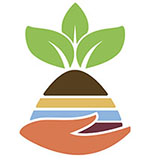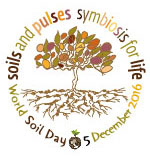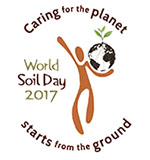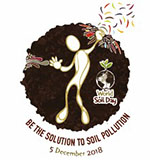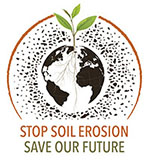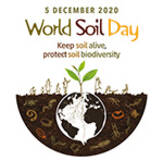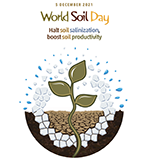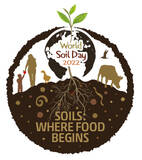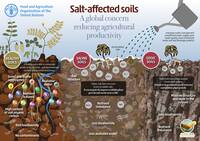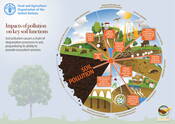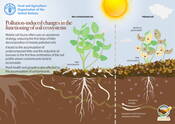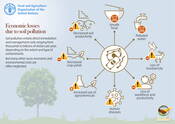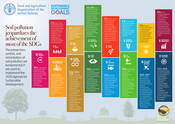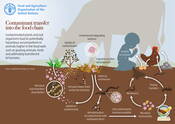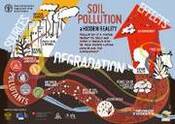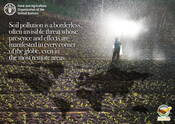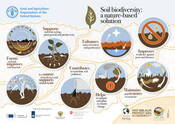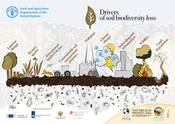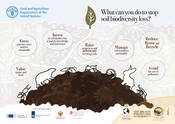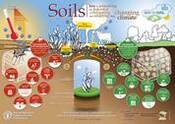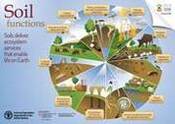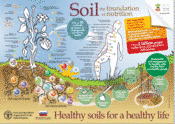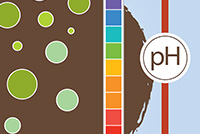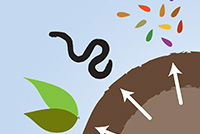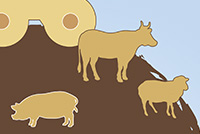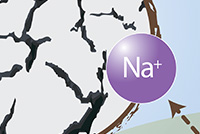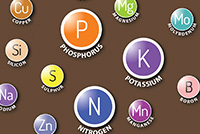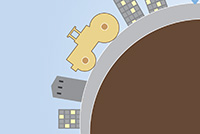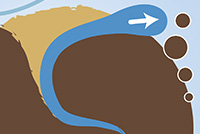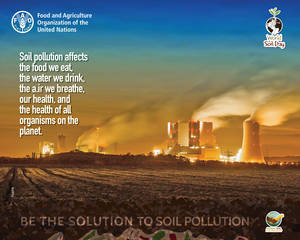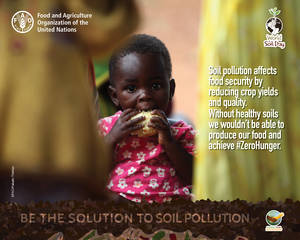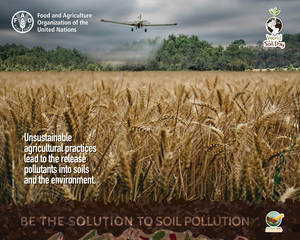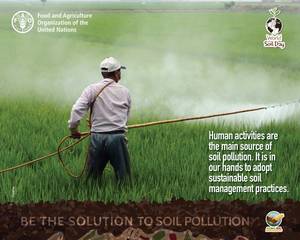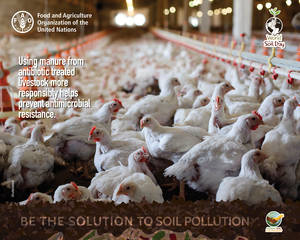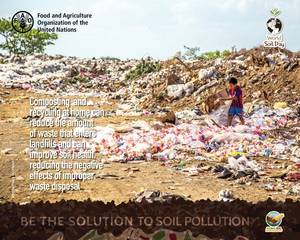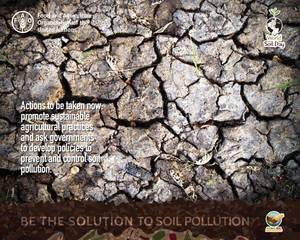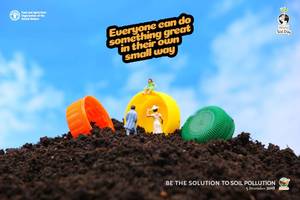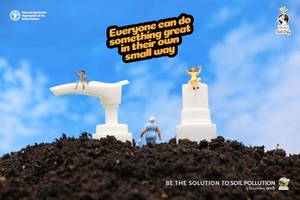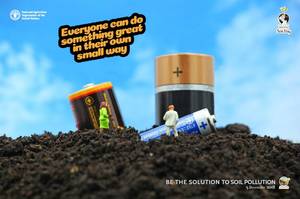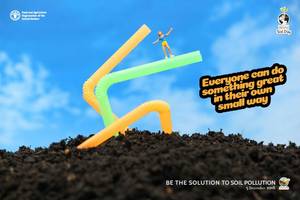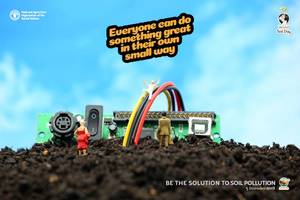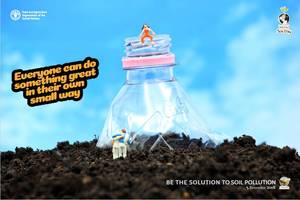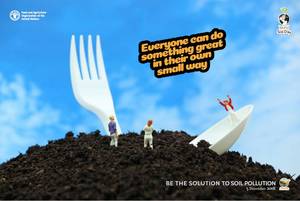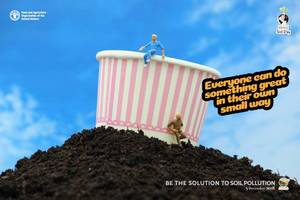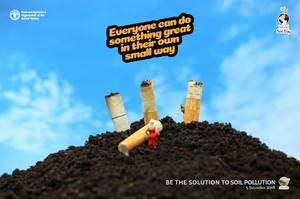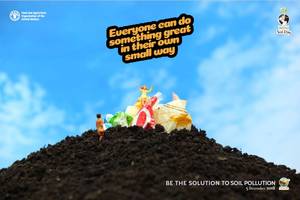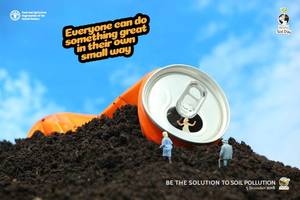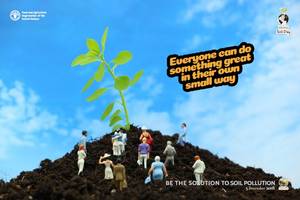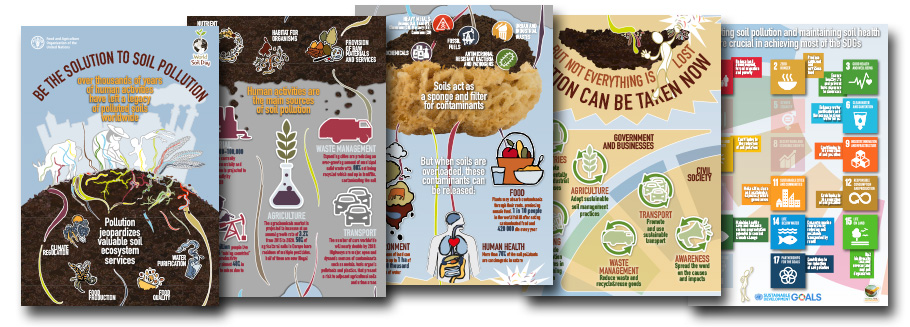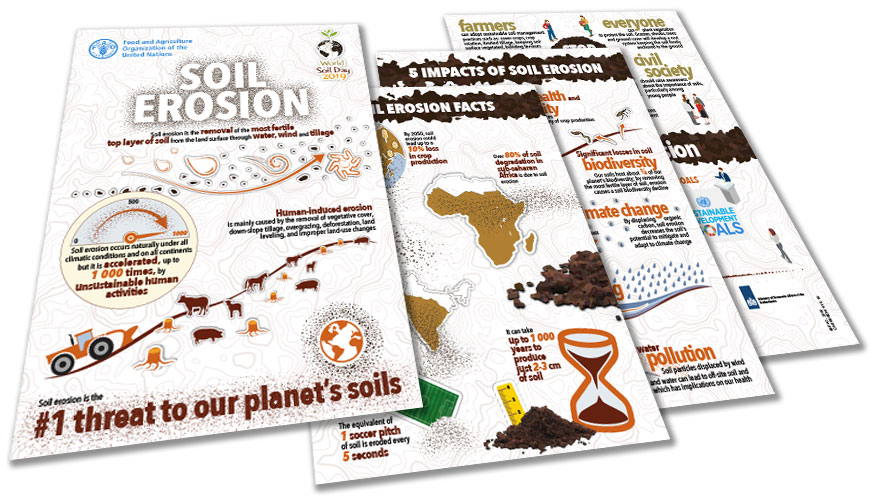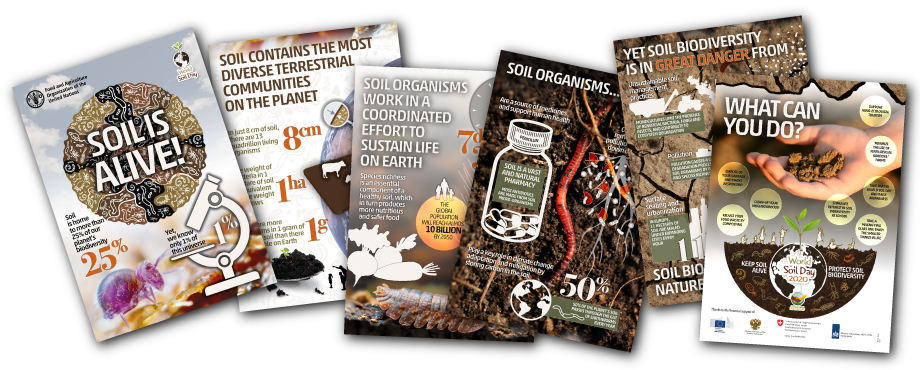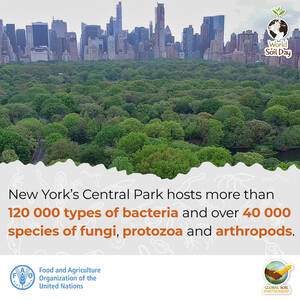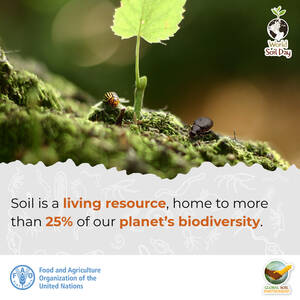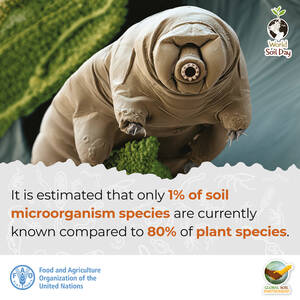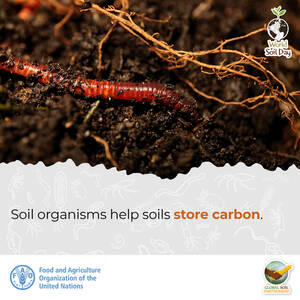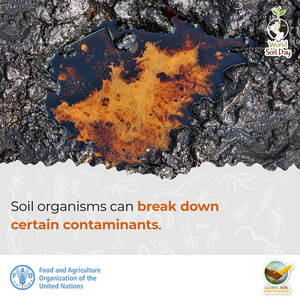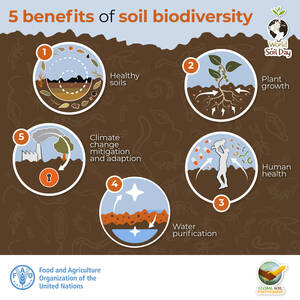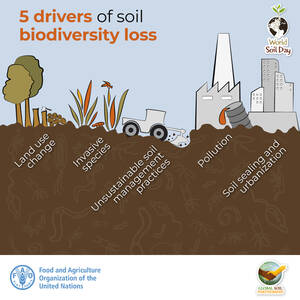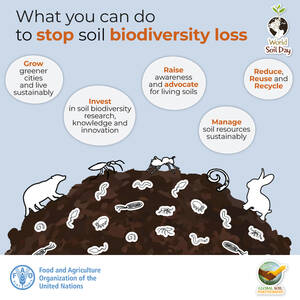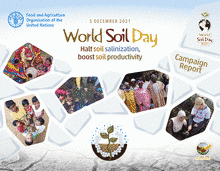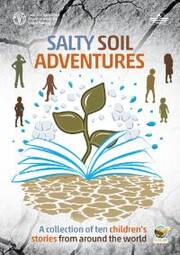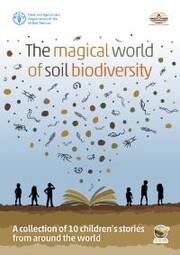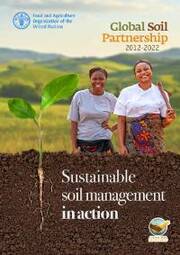
Awareness raising: advocating for healthy soils
World Soil Day and the International Year of Soil
GSP adopts a systematic awareness raising campaign on how soil relates to people’s everyday lives not only as part of the World Soil Day and the International Year of Soils but also as a sustained long-term outreach/engagement programme.
Glinka World Soil Prize and King Bhumibol WSD Award
The Glinka Prize is addressed to individuals or organizations committed to solving acute problems of soil degradation. The WSD Award is a recognition tool for individuals or institutions that have made an effort to organize successful WSD celebrations.
Communication campaigns
Prizes and Awards

Glinka World Soil Prize
Edition 2022 - Call for nomination to be launched soon
Are you a dynamic change-makers against soil degradation? All GSP Partners are invited to nominate individuals or organizations. Winner will be rewarded with a medal and a USD 15 000 check.
Send your nomination to a GSP partner

World Soil Day Award
Edition 2022 - Call for application to be launched soon
If you organized an exciting World Soil Day event for the campaign 2021 'Halt soil salinization, boost soil productivity', don't miss the chance to compete. You can win a medal and a check of USD 15 000.
Send your application to the GSP Secretariat
Contests
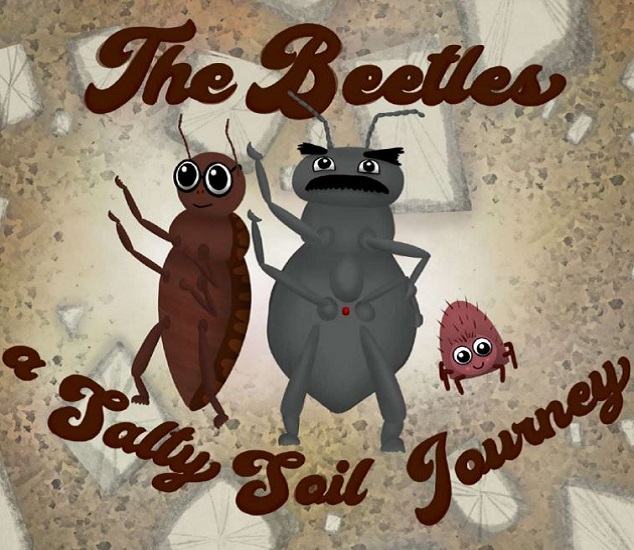
Children's booklet contest on soil salinization
5 December 2021 - T. Porter, F. López Campomane, L. Fausak, University of British Columbia, Canada, won the contest with "The Beetles: a Salty Soil Journey".
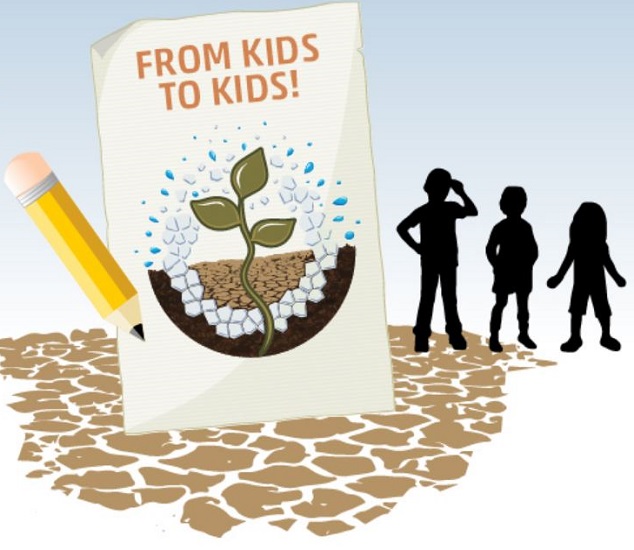
Kids2Kids poster drawing contest on soil salinization
5 December 2021 - M. and B. Venkatesh Hegde from the Water Alliance, United Arab Emirates won the first prize for both age categories.
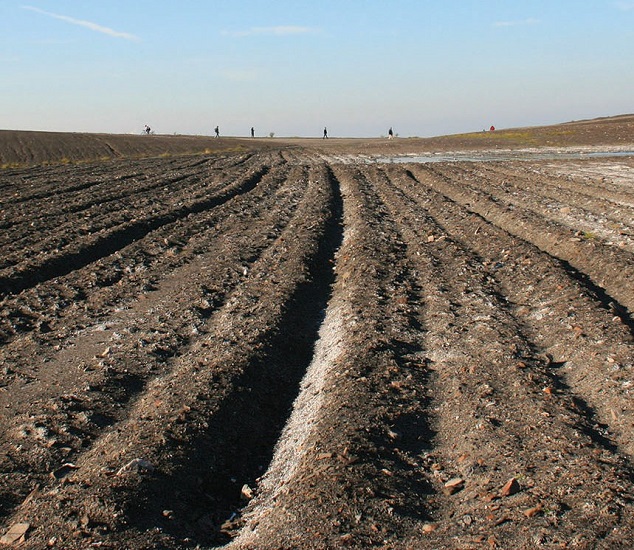
Photocontest on salt-affected soils
23 October 2021 - “Sodification with high RSC irrigation waters” by Ajay Bhardwaj, India won the 1st Prize in a tie with “Demonstration of the internal impact of soil salinity” by Gideon Américo Muiambo, Mozambique.
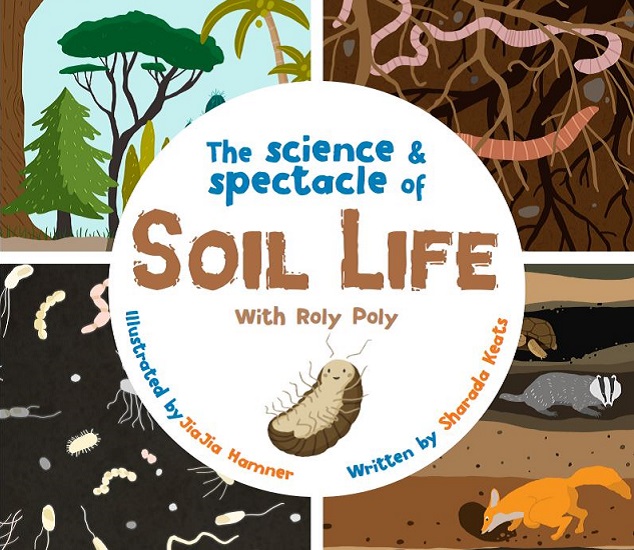
Booklet contest for children on soil biodiversity
5 December 2020 - J. Hamner and S. Keats, United Kingdom won the contest with "The science & spectacle of Soil Life by Roly Poly".
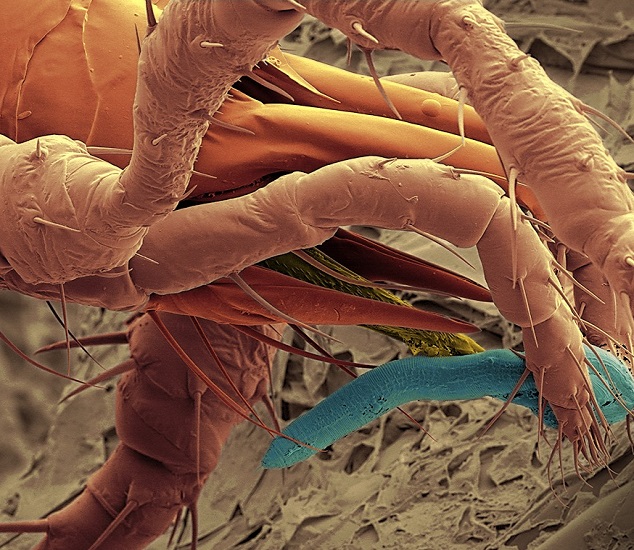
Photo and video timelapse contest on soil biodiversity
22 September 2020 - A. Samarasuriya, Sri Lanka and Eric Palesvky, Israel won the contest after the social media voting.
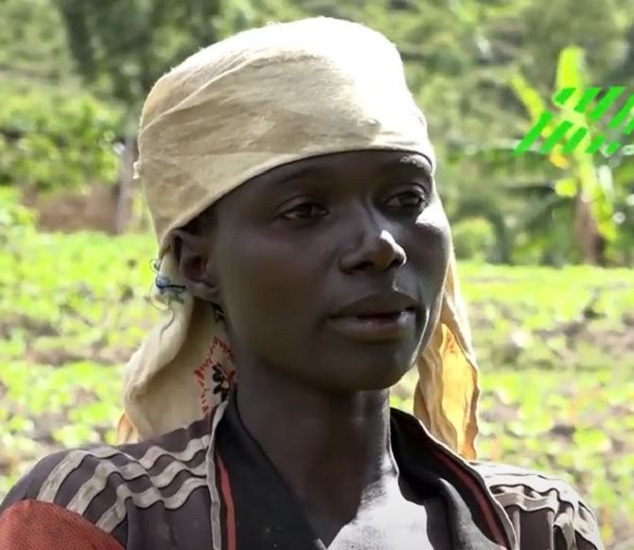
Video contest on soil erosion
17 May 2019 - The first prize goes to Aynoqás y Taqanas from Bolivia, produced by IIDEPROQ – UMSA, in collaboration with Sociedad Boliviana de la Ciencia del Suelo.
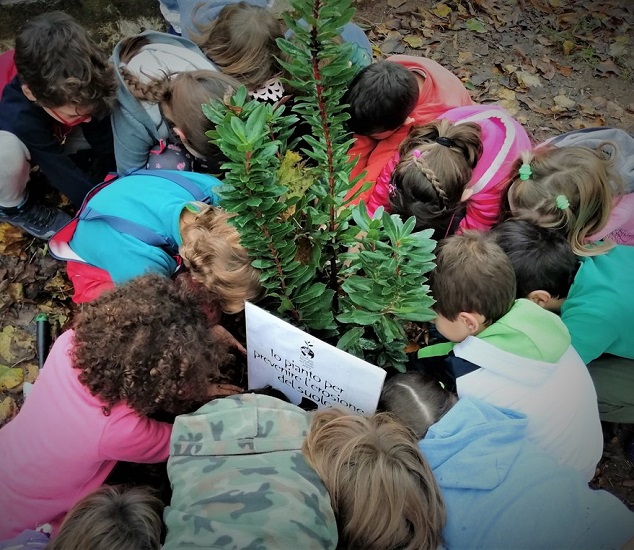
Greening the future challenge: Cover the soil to #StopSoilErosion
5 December 2019 - A. Radha Krishnan, Agriculture school Paranthan, Sri Lanka won the first prize for the contest..
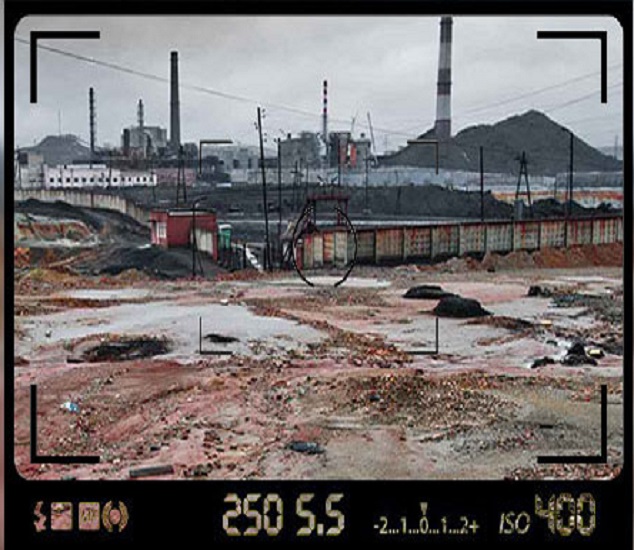
Photocontest on soil pollution
4 May 2018 - P. Adamo, A. Constantin, T. Leah, B. Fokke, T. Shinano, C. Bhola, S. Reiter were the 7 finalists whose photos were exposed in the FAO Atrium during #GSOP18.
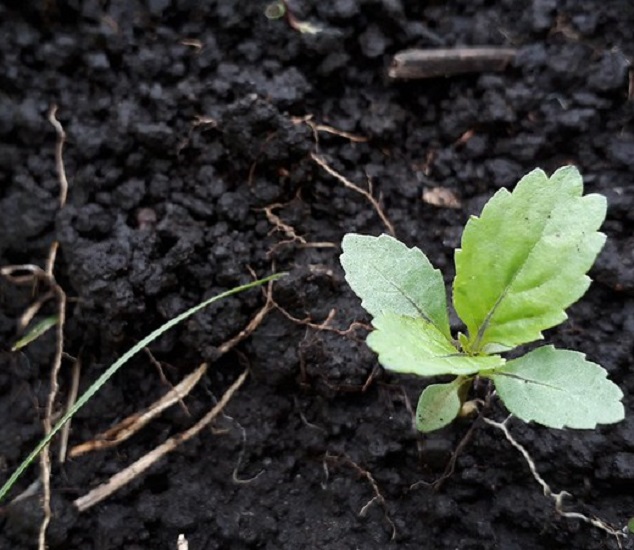
Black soils photocontest
5 December 2017 - Melody Morillo Orogo, the Philippines won the #WhenSoilsTurnBlack photo contest organized for the launch of International Network of Black Soils.
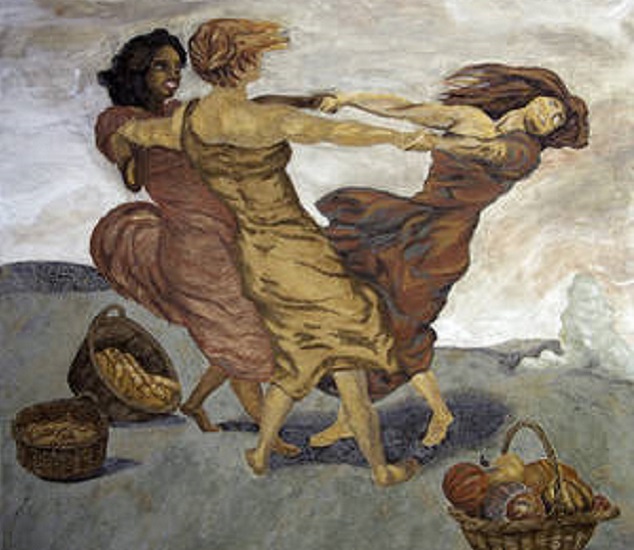
Soil painting initiative
5 December 2017 - Eighteen students from Cornell University, Ithaca, USA, won the contest with "The Three Sisters of Haudenosaunee agriculture".
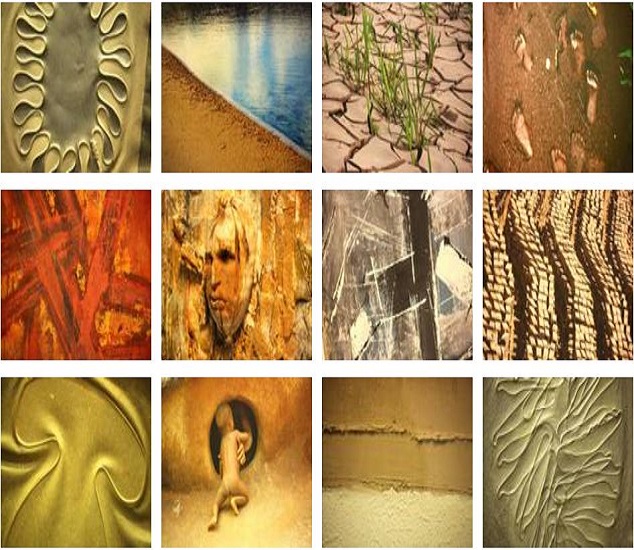
HeArt&Soils - Art exhibition
5 December 2017 - Thanks to artists H. Akhlaghi, A. Rabboni, A. Macchi, A. Di Fusco, A. Romeo, F. Lolli, M. Fioramanti, Q. Cipolla, R. Pezzino de Geronimo, R. Mannino.
In action

Halt soil salinization for WSD2021
THANK YOU for World Soil Day 2021
The communication campaign for WSD2021 drew attention to the global issue of salt-affected soils and the need for collective efforts to grant a food secure future to the next generations. Stay tuned for the launch of the 2022 campaign!

Symposium on Soil4Nutrition
26-29 July 2022, virtual meeting
The Global Symposium on Soils for Nutrition (GSOIL4N) aims to review the state of the art on the role of soil fertility in delivering sufficient, high quality, safe, and more nutritious food for better nourished plants, animals, and people.

Global Soil Doctors programme
Farmer-to-farmer training
The programme provides soil doctors with training, educational material and soil testing kits to build capacity on the principles of soil science and promote the practice of sustainable soil management at local and national level.
NEW Infographics
Soils and the SDGs
This infographic aims to raise awareness on soils and link healthy soils have with the UN Sustainable Development Goals (SDGs).
Social media cards and poster on soil salinization
Salt-affected Soils: A global concern reducing agricultural productivity
Soils affected by salinity and sodicity undergo a rapid decline of health, losing their capacity for biomass production, natural filtration, carbon sequestration and other necessary ecosystem functions.
French | Spanish | Chinese | Russian | Arabic | Catalan | Galician | Portuguese | Hebrew

Global Symposium on Salt-affected Soils
This high-level science-policy meeting #GSAS21 “Halt soil salinization, boost soil productivity” will be held in a virtual format from 20 to 22 October 2021.
Are all salt-affected soils a threat?
The differences between naturally saline and sodic soils and human-induced salinization and sodification.
Economical losses due to soil salinization
The global annual cost of salt-induced land degradation in irrigated areas is estimated to be USD 27.3 billion related to lost crop production.
Migration due to soil salinization
As climate change and water scarcity increase, more soils become salt-affected...forcing people to leave their once productive land and migrate.
What can you do? Halt soil salinization, Boost soil productivity
Raise awareness, promote the use of sustainable farming systems, invest in gathering better knowledge...
Farmers in action
Eight good practices to halt soil salinization and boost soil productivity: Practice halophytic agriculture, irrigate with good quality water...
Videos
Do you need one of those videos in high definition to display? Just send us an email and we will share it with you.
Salt-affected soils: discovering a missed reality
|
Soil salinization and sodification are major soil degradation processes threatening ecosystem and are recognized as being among the most important problems at a global level for agricultural production, food security and sustainability in arid and semi-arid regions. |
Halt soil salinization, Boost soil productivity
|
This video was presented during the World Soil Day 2021 communication campaign "Halt soil salinization, boost soil productivity". |
Protect black soils, invest in the future!
|
This video was presented during the International Forum on Black Soil Conservation and Utilization held in Jilin Province from 21 to 23 July 2021 by the Ministry of Agriculture and Rural Affairs of the People’s Republic of China (MARA). |
World Soil Day - 5 December 2020: Worldwide events and outreach
|
World Soil Day, 5 December 2020 was celebrated under the slogan “Keep soil alive, Protect soil biodiversity” with almost 800 events in 105 countries around the world. Millions of people were touched by the FAO Global Soil Partnership communication campaign. |
6 actions to keep soil alive
|
Soil organisms are essential for food security, climate change and the environment. An agenda for action on soil biodiversity is needed to protect, strengthen monitoring, and prevent further biodiversity loss. |
Beneath our feet
|
World Soil Day - Keep soil alive, Protect soil biodiversity, focuses on soil biodiversity as a key factor to achieve food security, mitigate climate change and improve human health. |
Keep soil alive, protect soil biodiversity
|
Keep soil alive, protect soil biodiversity This animation gives a brief introduction on the main drivers, the key functions and challenges of soil biodiversity loss, indicating possible ways to enhance soil biodiversity as a nature-based solution. English | عربية | 中文 | Français | Pусский | Español | Thai | Portuguese | Italian Short version: English |
Mission: Keep soil alive!
|
Soils are essential for food systems. Healthy soils allow us to grow a variety of food products needed for human nutrition and each of us depends on soil productivity. |
5 reasons why we need to cherish the ground beneath our feet
|
5 reasons why we need to cherish the ground beneath our feet Soils do amazing things for us that we sometimes take for granted. Here are 5 reasons why we need to cherish the ground beneath our feet. |
Soil erosion is threatening our food security
|
Soil erosion is threatening our food security Soil may not look like much but without it we wouldn't be able to produce our food! But soil erosion is threatening our food security. Every 5 seconds the equivalent of one soccer pitch is eroded! Once we lose this soil we won't see it again in our lifetime. If we don't act now, over 90% of the Earth's soils could become degraded by 2050. |
Stop soil erosion, Keep soil where it belongs
|
Stop soil erosion, Keep soil where it belongs Soil erosion poses a major threat to global food security and to the achievement of the Sustainable Development Goals (SDGs). Find out more about the effects of soil erosion and the ways we can prevent it. |
7 things you can do to stop soil pollution
|
7 things you can do to stop soil pollution Let's be the solution to stop soil pollution! |
How can you be the solution to soil pollution?
|
How can you be the solution to soil pollution? Even through your small actions you can contribute to a big goal, to #StopSoilPollution. Reduce, reuse and recycle can help you, your community by improving your health and the health of our soils. Short version: English |
Soil Pollution, a hidden reality
|
Soil Pollution, a hidden reality Soil is a complex growing habitat that remains productive only when it is cared for and nurtured. Combating and addressing soil pollution means assessing and minimizing the risks for food security, human health and the environment. |
The Global Soil Organic Carbon Map V1.0
|
The Global Soil Organic Carbon Map V1.0 The Global Soil Organic Carbon map V1.0 is an important stepping stone to better know the current Soil Organic Carbon stock stored beneath our feet and soils’ potential for further sequestration. |
Soil organic carbon, the treasure beneath our feet
|
Soil organic carbon, the treasure beneath our feet An animated illustration of soil organic carbon and its importance for climate action, food production and sustainable development. |
Soils and pulses, symbiosis for life
|
Soils and Pulses, Symbiosis for Life This short animation introduces the new book “Soils and Pulses: symbiosis for life”. Pulses contribute to soil health, food security and nutrition, and climate change adaptation and mitigation. |
Sustainable soil management and the Sustainable Development Goals
|
Sustainable soil management and the Sustainable Development Goals The Sustainable Development Goals were recently created with a view to achieve sustainable development by 2030. Of the 17 goals, four contain targets specifically related to Soils. This animation looks at some of the challenges we face in each of these goals and presents some of the methods we can use to tackle them. |
Soil: An essential ingredient to healthy food and nutrition
|
Soil: An essential ingredient to healthy food and nutrition Soils are by nature linked to the micronutrient content of our food production and they can help to reverse the increasing trend of nutrient depleted soil by adopting sustainable soil management practices. |
Soils: Our ally against climate change
|
Soils: Our ally against climate change A look at how our Soils help to combat climate change in their role of sequestering CO2, and how our collective habits can damage this benefit with potentially devastating consequences. |
Soil 101
|
Soil 101 is an animated introduction on soils prepared in the framework of the 2015 International Year of Soils. This 2 minutes video outlines the main soil functions and the threats currently facing them. English | العربية | 中文 | Français | Pусский | Español | čeština | |
The Status of the World’s Soil Resources
|
The Status of the World’s Soil Resources The world’s soils are rapidly deteriorating due to soil erosion, nutrient depletion, loss of soil organic carbon, soil sealing and other threats, but this trend can be reversed provided countries take the lead in promoting sustainable management practices and the use of appropriate technologies, according to the 'Status of the World’s Soil Resources'report. |
Let's talk about soils
|
This animated film tells the reality of soil resources around the world, covering the issues of degradation, urbanization, land grabbing and overexploitation; the film offers options to make the way we manage our soils more sustainable. |
Soils: a hidden resource
|
Soils are a limited natural resource, but their role in food security is crucial. In light of climate change, soil degradation and erosion, farmers struggle to protect soil health. |
Thematic infographic
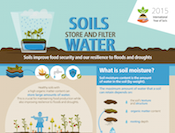
Soils store and filter water - Improving food security and our resilience to floods and droughts
Functional soils play a key role in the supply of clean water and resilience to floods and droughts.

Soils help to combat and adapt to climate change
Soils help to combat and adapt to climate change by playing a key role in the carbon cycle.

Soils are the foundation for vegetation
Healthy soils are crucial for ensuring the continued growth of natural and managed vegetation, providing feed, fibre, fuel, medicinal products and other ecosystem services such as climate regulation and oxygen production. Soils and vegetation have a reciprocal relationship.

Soils and Biodiversity
Soils host a quarter of our planet's biodiversity.Soil is one of nature's most complex ecosystems: it contains a myriad of organisms which interact and contribute to the global cycles that make all life possible.
French | Spanish | Chinese | Russian | Arabic Other languages: Hungarian

Healthy Soils are the Basis for Healthy Food Production
Healthy soils produce healthy crops that in turn nourish people and animals. Indeed, soil quality is directly linked to food quality and quantity.
French | Spanish | Chinese | Russian | Arabic Other languages: Turkish | Italian

Soil is a non-renewable resource. Its preservation is essential for food security and our sustainable future
Soil is a finite resource, meaning its loss and degradation is not recoverable within a human lifespan.
French | Spanish | Chinese | Russian | Arabic Other languages: Hungarian | Turkish | Italian | Indonesian

International Year of Soils 2015: Healthy soils for a healthy life (available soon)
Our soils are in danger because of expanding cities, deforestation, unsustainable land use and management practices, pollution, overgrazing and climate change.
French | Spanish | Chinese | Russian | Arabic Other languages: Czech | Turkish
Thematic factsheet

Soils store and filter water
Improving food security and our resilience to floods and droughts
Functional soils play a key role in the supply of clean water and resilience to floods and droughts. Water infiltration through soil traps pollutants and prevents them from leaching into the groundwater. Moreover, the soil captures and stores water, making it available for absorption by crops, and thus maximizing water use efficiency
Download PDF: High res | Low res
Official languages: French | Spanish | Chinese | Russian | Arabic

Soils help to combat and adapt to climate change by playing a key role in the carbon cycle
Healthy soils provide the largest store of terrestrial carbon. When managed sustainably, soils can play an important role in climate change mitigation by storing carbon (carbon sequestration) and decreasing greenhouse gas emissions in the atmosphere.
Download PDF: High res | Low res
Official languages: French | Spanish | Chinese | Russian | Arabic

Soils are the foundation for vegetation
which is cultivated or managed for feed, fibre, fuel and medicinal products
Healthy soils are crucial for ensuring the continued growth of natural and managed vegetation, providing feed, fibre, fuel, medicinal products and other ecosystem services such as climate regulation and oxygen production.
Download PDF: High res | Low res
Official languages: French | Spanish | Chinese | Russian | Arabic

A healthy soil is a living soil
Soils Host a Quarter of our Planet’s Biodiversity
Biological diversity or ‘biodiversity’ is described as “the variability among living organisms from all sources, whether terrestrial, aquatic or marine”. It includes the diversity within species (genetic diversity), between species (organism diversity) and of ecosystems (ecological diversity)
Download PDF: High res | Low res
Official languages: French | Spanish | Chinese | Russian | Arabic

Healthy soils are the basis for healthy food production
The most widely recognized function of soil is its support for food production
It is the foundation for agriculture and the medium in which nearly all food-producing plants grow. In fact, it is estimated that 95% of our food is directly or indirectly produced on our soils. Healthy soils supply the essential nutrients, water, oxygen and root support that our food-producing plants need to grow and flourish.
Download PDF: High res | Low res
Official languages: French | Spanish | Chinese | Russian | Arabic
Other languages - Italian - High res | Low res | Bahasa Indonesia - High res | Low res

Soil is a non-renewable resource
Its preservation is essential for food security and our sustainable future
Soil is a finite resource, meaning its loss and degradation is not recoverable within a human lifespan. As a core component of land resources, agricultural development and ecological sustainability, it is the basis for food,feed, fuel and fibre production and for many critical ecosystem services. It is therefore a highly valuable natural resource, yet it is often overlooked...
Download PDF: High res | Low res
Official languages: French | Spanish | Chinese | Russian | Arabic
Infographics
Abovegroundand belowground biodiversity: an inseparable interaction
The interaction between below and aboveground biodiversity, including several different animals, plants and bacteria that are part of this symbiotic relationship.
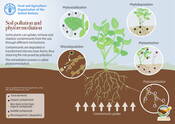
Soil pollution and phytoremediation
Some plants can uptake, remove and stabilize contaminants from the soil, through different mechanisms.
Impacts of soil pollution on key soil functions
Soil pollution causes a chain of degradation processes in soil, jeopardizing its ability to provide ecosystem services.
Pollution-induced changes in the functioning of soil ecosystems
Mobile soil fauna often uses an avoidance strategy, reducing the first steps of litter decomposition in heavily polluted soils.
Economic losses due to soil pollution
Soil pollution entails direct remediation and management costs ranging from thousands to billions of dollars per year, depending on the extent and type of contaminants.
Soil pollution jeopardizes the achievement of most of the SDGs
The prevention, control, and remediation of soil pollution are fundamental if we want to implement the 2030 Agenda for Sustainable Development.
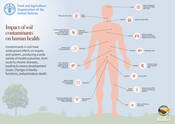
Impact of soil contaminants on human health
Contaminants in soil have widespread effects on organs and systems, producing a wide variety of health outcomes, from acute to chronic diseases, leading to severe development issues, changes in bodily functions, and premature death.
Contaminants tranfer to the food chain
Contaminated plants and soil organisms lead to potentially hazardous accumulations in animals higher in the food web such as grazing animals, birds and ultimately transferred to humans.
Soil pollution, a hidden reality
This poster presents in a nutshell the sources, degradation processes and effects of soil pollution on the environment, human health and food safety and security.
Other languages: Thai
Soil pollution is borderless
Soil pollution is a borderless often invisible threat whose presence and effects are present in every corner of the globe.
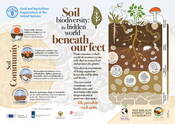
Soil biodiversity, the hidden world beneath our feet
Plants nurture a whole world of creatures in the soil, that in return feed and protect the plants.This diverse community of living organisms keeps the soil healthy and fertile.
French | Spanish | Chinese | Russian | Arabic Other languages: Catalan | Portuguese | Slovenian
Soils and pulses: symbiosis for life
The symbiotic and strategic alliance between soils and pulses contributes to improve soil health, adapt to and mitigate climate change, and ultimately to enhance food security and nutrition.
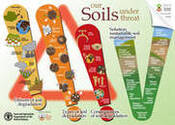
Soils under threat
Soils are under increasing pressure of intensification and competing uses for cropping, forestry, pasture, urbanization. These, combined with unsustainable management and climate extremes, cause degradation.
French | Spanish | Chinese | Russian | Arabic Other languages: Turkish | German | Thai | Georgian | Catalan
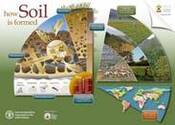
Soil formation
Formation of soil is a complex and long process which depends on 5 key formation factors. Soils around the world are very diverse and constitute a key element of our landscapes.
French | Spanish | Chinese | Russian | Arabic Other languages: Finnish | Swedish | German | Thai | Georgian | Catalan
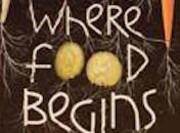
Where food begins
Healthy soils not only are the foundation for food, fuel, fibre and medical products, but they are also playing a key role in the carbon cycle, storing and filtering water, and improving resilience to floods and droughts.
العربية | 中文 | English | Français | Italiano | Русский | Portouguese | Español
Threats on soil functions
A series of 9 postcards focusing on the main soil threats have been produced together with a world map showing the condition and trend of each specific threat worldwide.
|
|
|
|
| |
Soil salinization and sodification | ||
|
| |
Soil Pollution cards | Be the solution
Would you like to be part of the solutions? 10 practical ways to 'Be the Solution' and contribute to #StopSoilPollution
Soil pollution | Postcards
EN: XS | Small | Medium | Large EN: XS | Small | Medium | Large EN: XS | Small | Medium | Large
ES: XS | Small | Medium | Large ES: XS | Small | Medium | Large ES: XS | Small | Medium | Large
FR: XS | Small | Medium | Large FR: XS | Small | Medium | Large FR: XS | Small | Medium | Large
EN: XS | Small | Medium | Large EN: XS | Small | Medium | Large EN: XS | Small | Medium | Large
ES: XS | Small | Medium | Large ES: XS | Small | Medium | Large ES: XS | Small | Medium | Large
FR: XS | Small | Medium | Large FR: XS | Small | Medium | Large FR: XS | Small | Medium | Large
EN: XS | Small | Medium | Large EN: XS | Small | Medium | Large
ES: XS | Small | Medium | Large ES: XS | Small | Medium | Large
FR: XS | Small | Medium | Large FR: XS | Small | Medium | Large
Soil Pollution Infographic
Discover the reality behind soil pollution and how you can be the solution!
Soil erosion | Long infographic
Discover soil erosion through the long infographic:
Arabic (print file | JPG) | Chinese (print file | JPG) | English (print file | JPG) | French (print file | JPG) | Russian (print file | JPG) | Spanish (print file | JPG)
Soil biodiversity | Long infographic

Where food begins
Healthy soils not only are the foundation for food, fuel, fibre and medical products, but they are also playing a key role in the carbon cycle, storing and filtering water, and improving resilience to floods and droughts.
Soil biodiversity | Did you know?
The 'Did you know?' cards can be downloaded here:
- New York's Central Part host more than 120 000 types of bacteria and over 40 000 species of fungi, protozoa, and arthropods
Arabic | Chinese | English | French | Russian | Spanish - Soil is a living resource, home to more than 25% of our planet's biodiversity
Arabic | Chinese | English | French | Russian | Spanish - It is estimated that only 1% of soil microorganism species are currently known compared to 80% of plant species
Arabic | Chinese | English | French | Russian | Spanish - Soil organisms help soils store carbon
Arabic | Chinese | English | French | Russian | Spanish - Soil organisms can break down certain contaminants
Arabic | Chinese | English | French | Russian | Spanish
Other languages: Portuguese
Soil biodiversity | Social media cards
The Social media cards can be downloaded here:
- 5 benefits of soil biodiversity
Arabic | Chinese | English | French | Russian | Spanish | Portuguese | Thai - 5 drivers of soil biodiversity loss
Arabic | Chinese | English | French | Russian | Spanish | Portuguese - What can you do to stop soil biodiversity loss
Arabic | Chinese | English | French | Russian | Spanish | Portuguese


